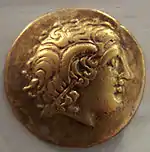Caturiges
The Caturiges (Gaulish: Caturīges, 'kings of combat') were a Gallic tribe dwelling in the upper Durance valley, around present-day towns of Chorges and Embrun, during the Iron Age and the Roman period.
Name
They are mentioned as Caturiges by Caesar (mid-1st c. BC) and Pliny (1st c. AD),[1] and as Katourgídōn (Κατουργίδων) by Ptolemy (2nd c. AD).[2][3]
The Gaulish ethnonym Caturīges (sing. Caturix) literally means 'kings of combat'. It stems from the Celtic root catu- ('combat, battle') attached to rīges ('kings').[4][5]
The city of Chorges, attested in the 4th c. AD as Caturrigas (Cadorgas in 1062, Chaorgias in 1338), is named after the tribe.[6]
Geography
The Caturiges dwelled in the upper course of the Durance river.[7] Their territory was located east of the Avantici and Edenates (further west lived the Vocontii), south of the Tricorii, Brigianii and Quariates, and north of the Bodiontici.[8] They were probably clients to the larger Vocontii as part of their confederation.[9]
Initially integrated into the province of Alpes Cottiae after the Roman conquest, the Caturiges were integrated into the province of Alpes Maritimae during the reign of Diocletian (284–305 AD).[7]
Eburodunum (modern Embrun), located on a rocky plinth that dominated the Durance river, was the main town of the Caturiges. It was an important station on the route between Gaul the Italian Peninsula.[10] After the western part of the province of Alpes Cottiae was transferred to the Alpes Maritimae under Diocletian (284–305), Eburodunum replaced Cemenelum as the capital of the Alpes Maritimae.[11]
Caturigomagus ('market of the Caturiges'; modern Chorges) was a frontier city located on the route to Italy via the Col de Montgenèvre, in the western part of the Caturigian territory near the border between the Regnum Cottii and the Vocontian confederation. Probably outshined by the neighbouring Eburodunum and Vappincum (Gap), the city declined in the 4th century AD and was not listed as civitates by the Notitia Galliarum ca. 400.[12]
History
In the mid-first century BC, the Caturiges are mentioned by Julius Caesar as a tribe hostile to Rome. In what appears to be a concerted attack, they attempted to prevent his passage through the upper Durance along with the Ceutrones and Graioceli in 58 BC.[13]
There [Titus Labienus] enrolled two legions, and brought out of winter quarters three that were wintering about Aquileia; and with these five legions made speed to march by the shortest route to Further Gaul, over the Alps. In that region the Ceutrones, the Graioceli, and the Caturiges, seizing points on the higher ground, essayed to stop the march of his army. They were repulsed in several actions; and on the seventh day he moved from Ocelum, the last station of Hither Gaul, into the borders of the Vocontii in Further Gaul.
They were eventually conquered by the Romans during the reign of Augustus (27 BC–14 AD).[7] They are mentioned in the Trophy of the Alps.[14]
According to Pliny, the Caturiges were originally part of the Insubres.[7]
Other communities that have perished are the Caturiges, an exiled section of the Insubrians...
References
- Caesar. Commentarii de Bello Gallico, 1:10:4; Pliny. Naturalis Historia, 3:125, 3:137.
- Ptolemy. Geōgraphikḕ Hyphḗgēsis, 3:1:35.
- Falileyev 2010, s.v. Caturiges.
- Lambert 1994, p. 36.
- Delamarre 2003, pp. 111, 261.
- Nègre 1990, p. 153.
- Graßl 2006.
- Talbert 2000, Map 16: Col. Forum Iulii-Albingaunum, Map 17: Lugdunum.
- Kruta 2000, p. 526.
- Lafond & Walser 2006.
- Graßl, Herbert (2006). "Alpes Maritimae". Brill’s New Pauly. doi:10.1163/1574-9347_bnp_e116390.
- Barruol 2004, pp. 403–404.
- Barruol 1969, p. 43.
- Pliny. Naturalis Historia, 3:137.
Primary sources
Bibliography
- Barruol, Guy (1969). Les Peuples préromains du Sud-Est de la Gaule: étude de géographie historique. E. de Boccard. OCLC 3279201.
- Barruol, Guy (2004). "Chorges / Caturigomagus (Hautes-Alpes)". Supplément à la Revue archéologique du centre de la France. 25 (1): 403–404. ISSN 1951-6207.
- Delamarre, Xavier (2003). Dictionnaire de la langue gauloise: Une approche linguistique du vieux-celtique continental. Errance. ISBN 9782877723695.
- Falileyev, Alexander (2010). Dictionary of Continental Celtic Place-names: A Celtic Companion to the Barrington Atlas of the Greek and Roman World. CMCS. ISBN 978-0955718236.
- Graßl, Herbert (2006). "Caturiges". Brill's New Pauly. doi:10.1163/1574-9347_bnp_e229360.
- Kruta, Venceslas (2000). Les Celtes, histoire et dictionnaire : des origines à la romanisation et au christianisme. Robert Laffont. ISBN 2-221-05690-6.
- Lafond, Yves; Walser, Gerold (2006). "Eburodunum". Brill’s New Pauly. doi:10.1163/1574-9347_bnp_e325670.
- Lambert, Pierre-Yves (1994). La langue gauloise: description linguistique, commentaire d'inscriptions choisies. Errance. ISBN 978-2-87772-089-2.
- Nègre, Ernest (1990). Toponymie générale de la France. Librairie Droz. ISBN 978-2-600-02883-7.
- Talbert, Richard J. A. (2000). Barrington Atlas of the Greek and Roman World. Princeton University Press. ISBN 978-0691031699.
